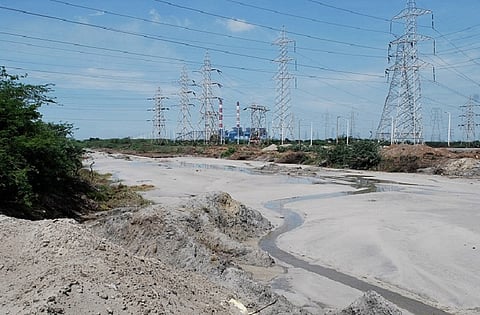

Industrial activities, especially coal fly ash pollution, have drastically altered the hydrology, ecology and topography of the Ennore creek, an expert study has found.
Commissioned by the National Green Tribunal (NGT), the study assessed the environmental impact of coal fly ash contamination on the ecologically sensitive Ennore Creek and the areas surrounding Tamil Nadu Generation and Distribution Corporation's (TANGEDCO) North Chennai Thermal Power Station (NCPTS).
The three-member panel that carried out the study included Dr Sultan Ahmad Ismail, director, Ecoscience Research Foundation, Dr D Narasimhan, Associate Professor (Retd.), Department of Botany, Madras Christian College, and Dr Balaji Narasimhan, Associate Professor, Department of Civil Engineering, IIT Madras.
In its interim report, the expert committee observed that "the water, flora and fauna in the area were severely contaminated with toxic chemicals, some of which can, with reasonable certainty, be linked to coal fly ash".
Fly ash pollution
In July this year, the Southern Bench of the NGT had rapped TANGEDCO for failing to remove fly ash from the Ennore Creek. It also gave the plant a week's time to fix leakages in the ash pipes, failing which both its units could be ordered to shut down.
According to the study, the existing ash pond used by NCTPS is in violation of environmental rules as it was found to be completely unlined.
It was also noted that NCTPS does not have a "response protocol for fly ash spills caused by leaking pipelines or failure of impoundment structures. The latter can release very large quantities of coal ash into the environment with grave immediate and long-term consequences."
While TANGEDCO, in its submission to the tribunal, stated that the total estimated quantum of settled fly ash is 2,18,257 m3, the study stated that this number was far lower than reality.
"This appears to be only less than two per cent of total fly ash volume that is in discrepancy. Still more than 98 per cent of fly ash has to be accounted for and has to be recovered from the site," the study noted.
The likely extent of fly ash in rivers, canals and water bodies, as estimated in the study, was around 309 hectares.
Impact on biodiversity
The tail end of the Kosasthalai River is considered an ecologically sensitive zone due to the presence of a varied range of habitats such as mangroves, salt marshes and mudflats.
Explaining how fly ash has been polluting the stretch, the study states, "Fly ash is transported as a slurry using sea water and dumped into the fly ash pond. Leaky pipelines, leaks from fly ash ponds and accidental breaches seem to have caused the spread of fly ash over large areas of the Kosasthalai river and Ennore backwaters. Fly ash pollution has typically and chemically altered the ecosystem."
The panel observed that "intertidal, aquatic and terrestrial habitats have been altered lost and degraded".
Vegetation along the river bank near the NCTPS was found to be under heavy stress. The population of mangroves and saline marsh species have also seen a decline, making the region vulnerable to coastal calamities.
Water quality
Water samples collected from the Kosasthalai River, backwaters and a secondary pond were found containing elevated levels of several toxic chemicals.
Borewell samples taken from Seppakkam, a village in the west of the ash pond, were found severely contaminated with copper, manganese, cadmium, mercury, selenium, lead, chromium and nickel. The metals present were at levels in excess of Indian drinking water standards. The samples from the backwaters were also contaminated above the permissible limits.
Impact on marine life and vegetation
Twenty samples of fishes, including fin fish, crab, prawn and oyster/mussels, were tested along with five samples of locally home-grown vegetables such as drumsticks, drumstick leaves, brinjal and ladies finger.
High levels of lead and cadmium, in excess of concentration limits prescribed by European Union Regulations, was found in the fishes.
Copper, which can cause deformity of gills and also harm olfactory abilities of fishes, was found in all the samples. Selenium found in samples can affect the reproductive ability of fishes. Lead was found in all oyster samples; consuming this can harm the bones and mental development of children.
The vegetables that were studied also had "detectable and significant levels" of chromium and lead.
The fisher community is most affected, socially and economically, by the adverse effects of fly ash pollution.
Many local fishermen have noted the disappearance or decline of several fish species such as white prawns (vellai iral), black prawns (karuppu iral), sand prawns (mann iral), tiger prawn, green crab, grey eel catfish (irun keluthi), mullte (madavai), silver biddy (oodan), sea bass (koduvai) and kalvaan, uppathi and panna.
The panel recommended a separate study on the effect of fly ash on human health. However, it noted that "the chemicals found in the water and fish are known to exert a variety of health effects on virtually every system of the human body, including the reproductive system, central and peripheral nervous systems, cardiovascular system, gastrointestinal systems, etc. Some of the metals are carcinogens, and some affect the brain and kidneys, and can even harm the developing foetus."
The study also recognised fishermen, who are exposed to the contaminated water for long periods of time, and fish consumers to be at risk.
Restitution and remediation
The panel recommended that the entire process of cleaning and restoring the area to its natural condition should be based on the principles of "sound science, polluter pays and public participation".
It advised that an independent entity with experience in restoring fly ash contaminated sites should be engaged in the project.
People who have been adversely affected by the pollution should also be compensated, it said.